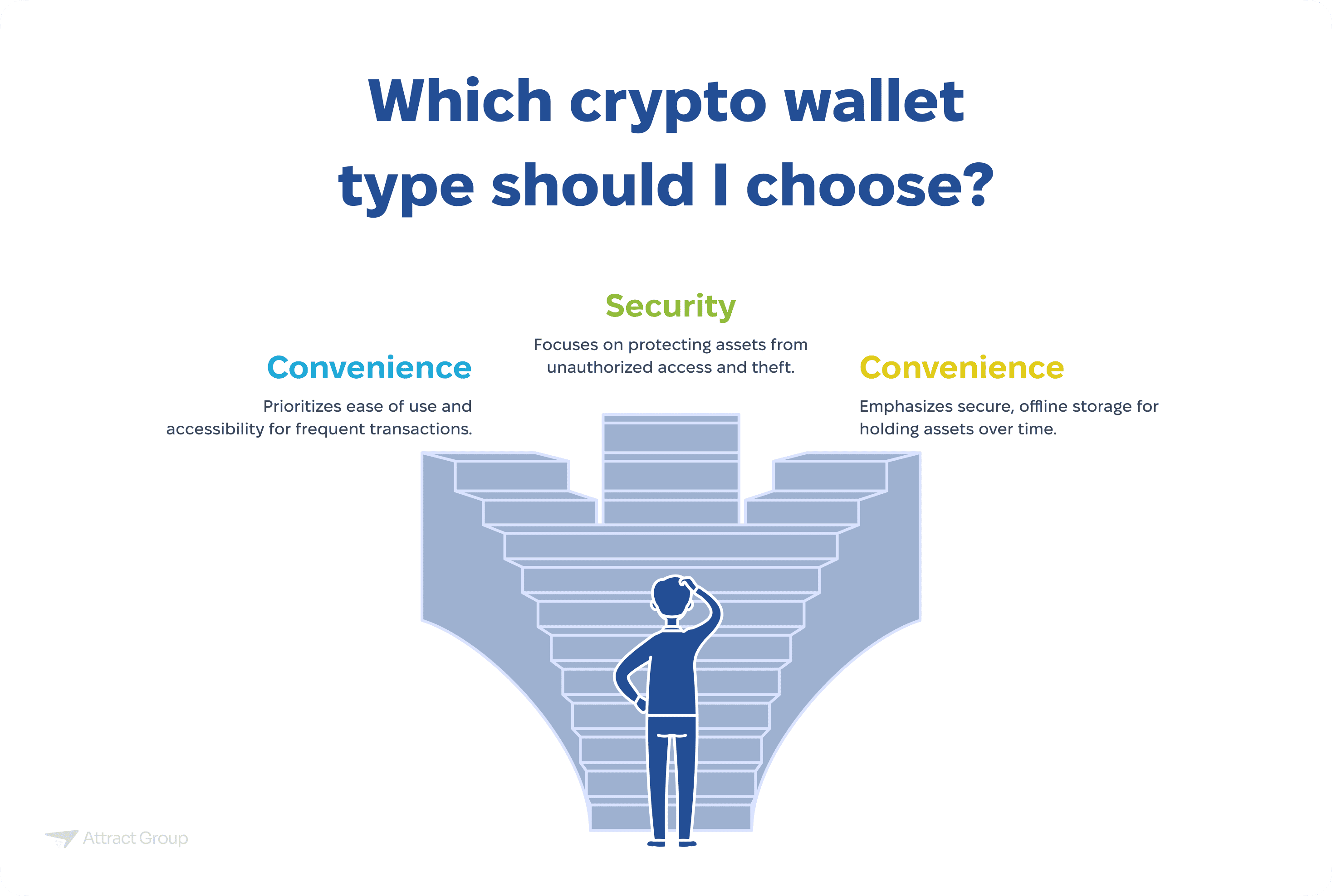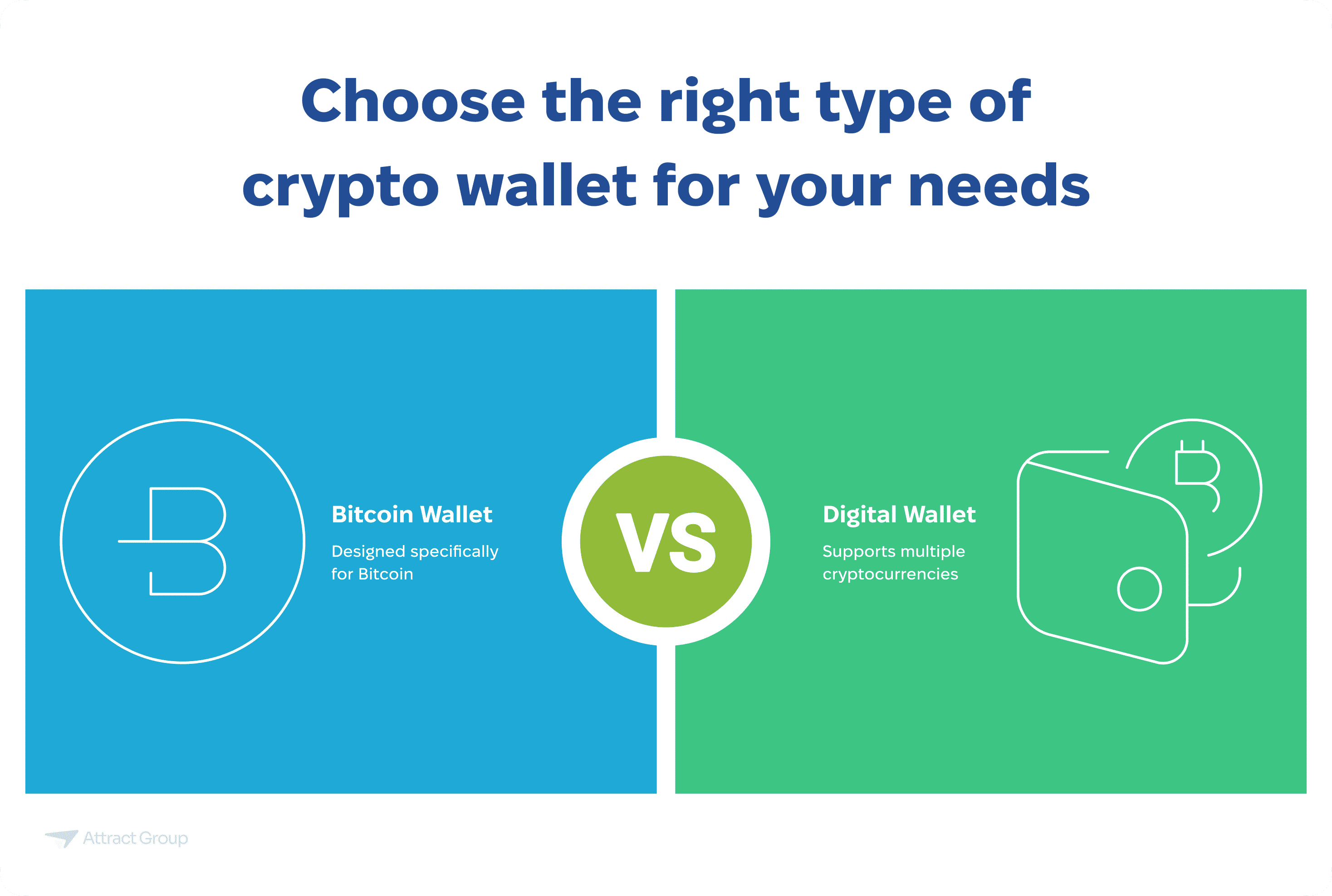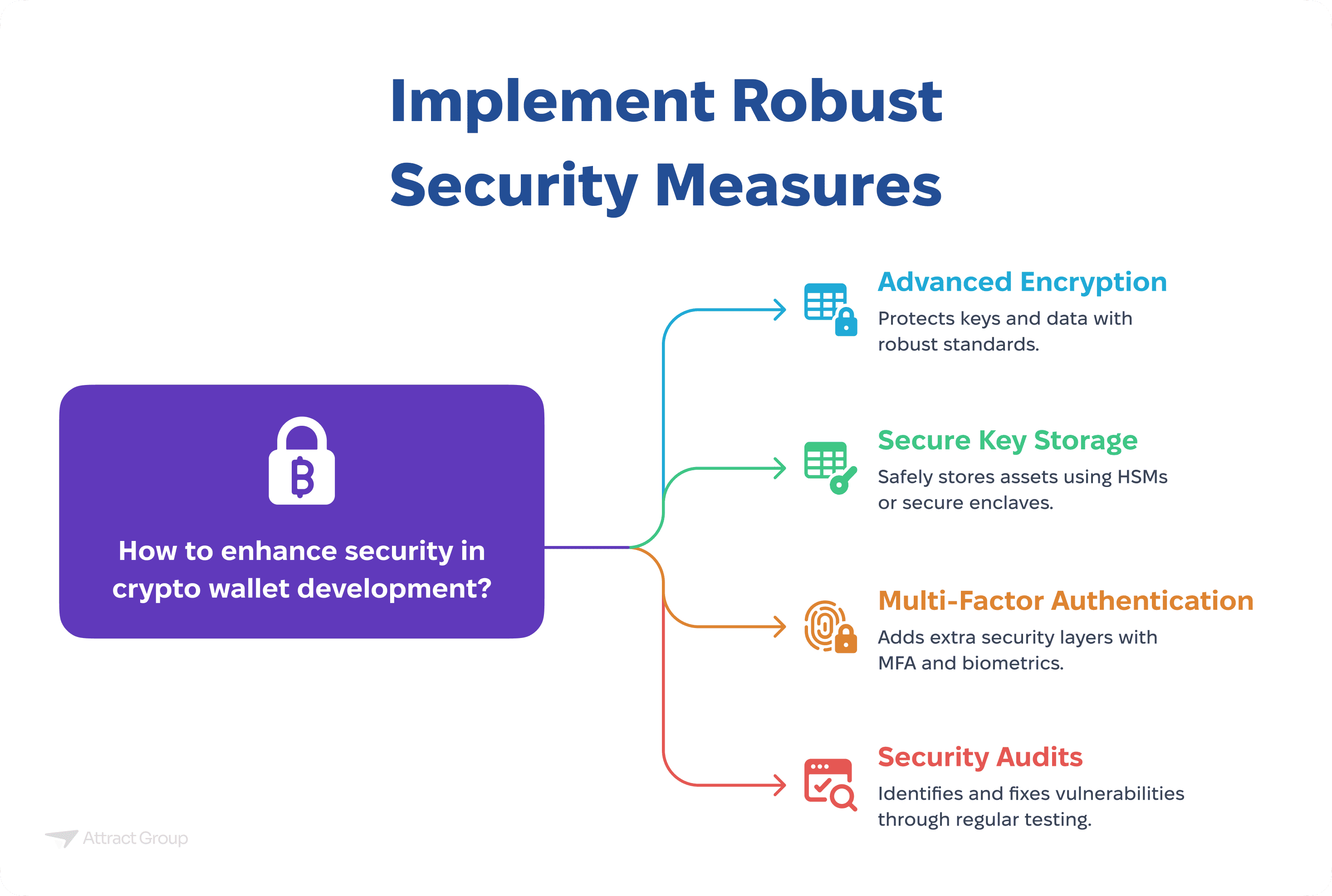How to Create a Crypto Wallet: Best Practices for Developers
 3 December 2024
3 December 2024🔊 Listen to the Summary of this article in Audio
A crypto-wallet is a digital tool that lets you store, send, and receive cryptocurrencies. It holds your private keys or P-keys, which are like secret passwords that give you access to your digital money. You can use a wallet app on your phone or computer to manage your funds easily. When you create a crypto wallet, you need to choose one that fits your needs and is secure. There are different types of crypto wallets, like software wallets, hardware wallets, and paper wallets.
Security is very important in cryptocurrency wallet development. If someone gets your P-keys, they can steal your money. Developers need to build wallets that protect their assets from hackers and other threats. This means using strong encryption and keeping up with the latest security practices. By focusing on security, developers help you keep your cryptocurrencies safe.
Types of Crypto Wallets

There are multiple crypto wallet types that offer unique benefits and drawbacks. Choosing the right wallet depends on your needs, whether you prioritize convenience, security, or long-term storage. Here are some examples:
Custodial Wallets
A custodial wallet is managed by a third party, like a cryptocurrency exchange. They hold your P-keys, making it easy for you to use the wallet without worrying about security details. You don’t have to create a crypto wallet from scratch, as the service takes care of everything. This type of wallet is great for beginners who want simplicity, but it requires trusting the provider. Popular examples include Coinbase Wallet and Binance Wallet.
| Pros | Cons |
|---|---|
| Easy to use, ideal for beginners. | You don’t control your funds. |
| Recovery options if you lose access. | Vulnerable to exchange hacks. |
| No need to set up a crypto wallet yourself. | Relies on a third party for security. |
Non-Custodial Wallets
A non-custodial wallet gives you complete control of your P-keys and funds. It’s the perfect choice for users who want a self-custody wallet and full independence. You are solely responsible for securing your P-keys, which means better security but also more responsibility. Non-custodial wallets are ideal for users who prioritize privacy and control. Examples include MetaMask, Trust Wallet, and Exodus.
| Pros | Cons |
|---|---|
| Full control over your funds. | Requires careful management of private keys. |
| Safer from third-party failures. | No recovery if private keys are lost. |
| Perfect for creating a self-custody wallet. | Responsibility for security is entirely yours. |
Software Wallets
A software wallet is a type of digital wallet that runs as an app on your phone or computer. It’s convenient and easy to use, making it great for daily transactions or managing different types of crypto. However, since it’s always connected to the internet, it’s considered a hot wallet and more vulnerable to online attacks. Examples include MyEtherWallet, Electrum, and Atomic Wallet.
| Pros | Cons |
|---|---|
| Simple to use with a wallet app. | Vulnerable to malware and phishing attacks. |
| Convenient for frequent transactions. | Always connected, making it less secure. |
| Easy to set up a crypto wallet for beginners. | Not ideal for storing large amounts. |
Hardware Wallets
A hardware wallet is a physical device that securely stores your P-keys offline. It’s one of the safest options for storing large amounts of cryptocurrency or holding assets long-term. These wallets act as cold wallets, keeping your funds safe from online threats. They are more expensive but offer unmatched security for users who value safety above all. Popular examples include Ledger Nano X and Trezor Model T.
| Pros | Cons |
|---|---|
| Excellent security as it stores keys offline. | Can be expensive compared to other options. |
| Great for cold wallets and long-term storage. | Not as convenient for frequent transactions. |
| A hardware wallet is immune to online attacks. | Needs careful storage to avoid physical loss. |
Paper Wallets
A paper wallet is a printed document that contains your private and public keys. It’s an offline storage method, making it another wallet option for long-term storage. Paper wallets are ideal for users who want a simple and cost-effective solution. However, they can be easily damaged or lost, so proper storage is crucial. To create one, you can use wallet generators like BitAddress or WalletGenerator.
| Pros | Cons |
|---|---|
| Immune to online hacking. | Easily lost, stolen, or damaged. |
| Cost-effective and simple. | No recovery if the paper is destroyed. |
| Another wallet option for offline storage. | Difficult to use for regular transactions. |
Key Components of a Secure Crypto Wallet
A secure crypto wallet must include features that protect your funds and personal information from threats like hackers and data breaches. Below is a table summarizing the key components and their importance:
| Component | Description | Why It’s Important |
|---|---|---|
| Private Key Security | Securely generates and stores P-keys using strong cryptography. | P-keys are the backbone of wallet security; their loss or exposure can lead to stolen funds. |
| Encryption | Uses robust encryption to protect P-keys and wallet data. | Prevents unauthorized access to sensitive information. |
| User Authentication | Includes passwords, PINs, biometrics, or two-factor authentication (2FA). | Adds an extra layer of security against unauthorized wallet access. |
| Backup and Recovery | Provides seed or recovery phrases to restore wallet access. | Ensures you can recover your wallet if your device is lost or damaged. |
| Secure Transactions | Signs transactions locally without exposing private keys online. | Prevents private keys from being intercepted during transactions. |
| Regular Updates | Offers ongoing software updates to patch vulnerabilities and improve security. | Keeps the wallet protected against new threats and ensures compatibility with blockchain networks. |
| Multi-Signature Support | Requires multiple keys to approve a transaction. | Reduces the risk of loss or theft by adding another layer of control. |
| Anti-Phishing Measures | Provides tools to detect phishing attempts and ensure genuine wallet interaction. | Protects users from scams and fake wallet interfaces. |
| Hardware Wallet Support | Allows integration with hardware wallets for enhanced security. | Combines the convenience of soft wallets with the security of hardware wallets. |
Transform your crypto strategy with a tailored wallet solution that meets your unique business requirements.
How to Integrate Crypto Wallets with Blockchain Networks
Step 1: Understand What a Crypto Wallet Is
A crypto wallet is a tool that lets users store, send, and receive cryptocurrencies safely. For example, a bitcoin wallet is designed specifically for Bitcoin, while a digital wallet can support multiple types of cryptocurrencies. Knowing the basics will help you make better decisions during development.
Step 2: Decide on the Type of Wallet
Think about the kind of wallet you want to create. Will it support only one cryptocurrency or several? Also, decide if users will need to create an account to use your wallet. Planning these details is a crucial part of crypto wallet app development.

Step 3: Plan Your Wallet’s Features
Outline the features you want to include. Do you want users to be able to buy crypto directly from your app? Consider how users will create a wallet and what security measures you’ll implement. Focusing on user-friendly design and strong security is key.
Step 4: Choose How to Develop Your Wallet
Decide whether to use a wallet provider to help build your wallet or to develop it from scratch. Using a provider can make the process faster but might limit customization. Building it yourself allows for more control over the wallet application.
Step 5: Integrate with Blockchain Networks
Connect your wallet to networks like Bitcoin or Ethereum. This integration enables users to perform crypto transactions such as sending and receiving funds. Make sure to include features that help users set up your wallet easily after downloading it.
Step 6: Develop the Crypto App
Begin coding your crypto app, ensuring it is secure and easy to use. Pay attention to how users will get a crypto wallet through your app and how they will interact with its features.
Step 7: Test Your Wallet Thoroughly
Test your cryptocurrency wallet app carefully to find and fix any issues. Make sure all features work smoothly before releasing it to the public.
Step 8: Launch Your Wallet
Once testing is complete, release your wallet on app stores. Provide clear instructions so users can easily find and download your app.
Step 9: Provide Support and Updates
Offer customer support to assist users with any problems. Keep the app updated to maintain security and add new features. Encourage users to regularly update and secure their wallets.
Need seamless blockchain network integration for your crypto wallet?
Best Practices in Crypto Wallet Development
Implement Robust Security Measures
Security is paramount in crypto wallet development. Employ advanced encryption standards to protect public and private keys and sensitive user data. Utilize secure key storage solutions, such as hardware security modules (HSMs) or secure enclaves on devices, to safely store your crypto assets. Implement multi-factor authentication (MFA) and biometric verification to add extra layers of security. Regularly conduct security audits and penetration testing to identify and fix vulnerabilities.

Ensure User-Friendly Interface and Experience
Design an intuitive and easy-to-navigate user interface. Simplify complex processes like transaction signing, backup, and recovery to make them accessible even to non-technical users. Provide clear instructions and helpful prompts to guide users through the wallet’s features, such as generating a wallet address to receive crypto or initiating transactions to transfer crypto. A positive user experience encourages adoption and reduces the likelihood of user errors that could compromise security.
Maintain Cross-Platform Compatibility
Develop the wallet to be accessible on multiple platforms, such as iOS, Android, and web browsers. Ensure the app is readily available in major app stores for easy download and updates. Maintain consistency in functionality and user experience across all platforms. Implement responsive design principles so that the wallet adapts seamlessly to different screen sizes and devices. Cross-platform compatibility enhances user convenience and broadens your potential user base.
Stay Compliant with Regulatory Standards
Adhere to the legal and regulatory requirements in the jurisdictions where your wallet will be used. If your wallet integrates features similar to a crypto exchange, implement necessary compliance measures like Know Your Customer (KYC) and Anti-Money Laundering (AML) protocols. Keep abreast of changes in laws related to data protection, such as the General Data Protection Regulation (GDPR), and ensure your wallet complies with these regulations to avoid legal repercussions.
Provide Continuous Support and Updates
Establish a system for regular updates to address security vulnerabilities and improve functionality. Engage with the user community to gather feedback and respond to issues promptly. Keep up with the latest developments in digital assets like Ethereum to provide users with up-to-date features and support. Provide comprehensive support resources, including documentation, FAQs, and customer service channels. Continuous support and updates not only enhance security but also improve user trust and satisfaction.
Our end-to-end development services cover everything from initial design to launch, ensuring a powerful, secure, and user-friendly solution.

Conclusion
Creating a secure and user-friendly wallet requires thoughtful planning and adherence to best practices. Whether you’re looking to create a cryptocurrency wallet for personal use or to serve a wide audience of crypto users, the process starts with understanding how to choose a wallet that balances convenience and security. A well-designed wallet ensures seamless transactions, safe storage, and reliable access to your crypto, whether through a mobile app or a wallet application on your computer.
For developers, taking the time to build a cryptocurrency wallet that prioritizes encryption, regulatory compliance, and ease of use is key to gaining user trust. Since a crypto wallet is an essential tool for managing digital assets, your focus should remain on delivering a secure platform that makes it simple to access your crypto without compromising safety.
At The Attract Group, we specialize in helping businesses and developers create a cryptocurrency wallet that meets the needs of both beginners and advanced users. From secure wallet architecture to seamless app design, we provide end-to-end support to bring your vision to life. If you’re ready to start your journey, contact us today — we’re here to help you build something exceptional!










